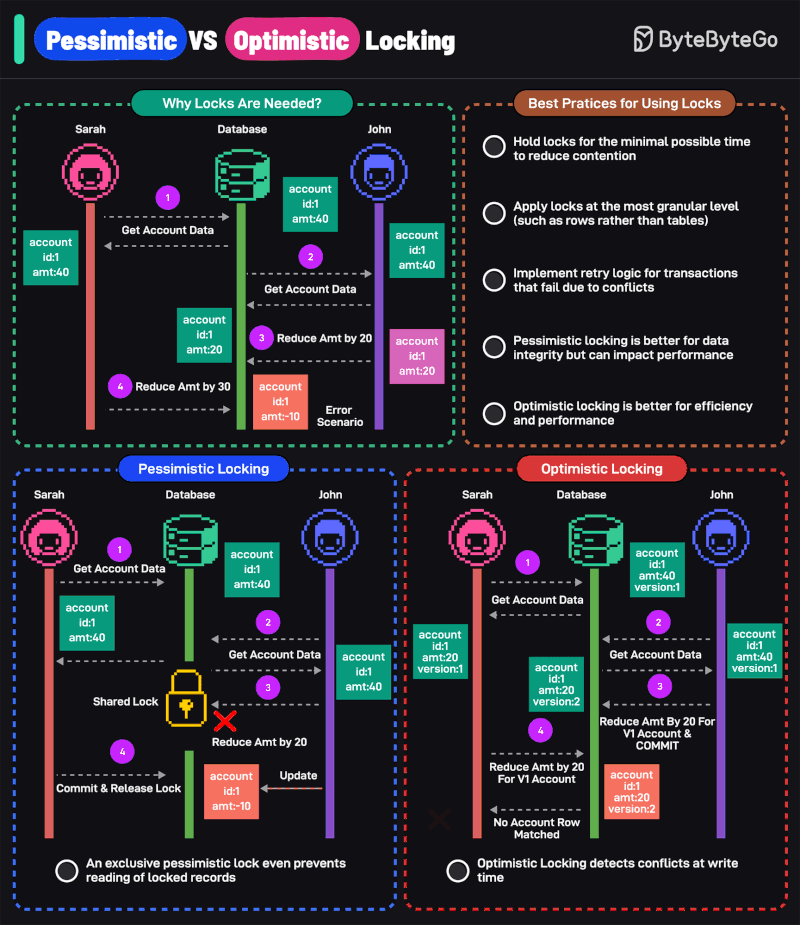In multi-user environments, maintaining data consistency and integrity is paramount. Locks play a crucial role in preventing simultaneous modifications that could lead to inconsistencies. Two widely used strategies for managing concurrency are pessimistic locking and optimistic locking. Understanding their differences, benefits, and trade-offs is essential for designing robust systems.

What Are Locks, and Why Are They Important?
Locks are mechanisms used in databases and distributed systems to control access to resources. They ensure that only authorized transactions modify data, preventing issues like:
- Dirty Reads: Reading uncommitted data.
- Lost Updates: Overwriting changes made by another transaction.
- Inconsistent Reads: Retrieving data that changes mid-operation.
Locks ensure that systems behave predictably, even under heavy loads. However, the choice of locking mechanism—pessimistic or optimistic—can significantly impact system performance and usability.
Pessimistic Locking: Planning for Conflicts
Pessimistic locking assumes that conflicts will occur. It prevents them by locking the data before any operation is performed.
- How It Works:
When a user accesses a piece of data, it’s locked, preventing other users from making changes until the operation is completed, and the lock is released. - Benefits:
- Guarantees data integrity, especially in environments with high contention.
- Ideal for use cases where data conflicts are unacceptable, such as financial systems or inventory management.
- Drawbacks:
- Can lead to significant performance bottlenecks, especially in high-traffic systems.
- Other users may experience delays or be blocked, leading to potential deadlocks.
Optimistic Locking: Hoping for the Best
Optimistic locking assumes that conflicts are rare and allows users to access and modify data simultaneously. It only checks for conflicts when changes are about to be committed.
- How It Works:
Each piece of data has a version identifier or timestamp. When a transaction attempts to save changes, it checks if the version or timestamp matches the current state. If it doesn’t, the system detects a conflict, and the operation is rolled back. - Benefits:
- Excellent for scenarios with low contention, such as CRM or analytics applications.
- Improves efficiency and performance since locking overhead is minimized.
- Drawbacks:
- Relies on robust conflict detection and resolution mechanisms.
- Requires retry logic to handle failed transactions.
Choosing the Right Locking Strategy
The choice between pessimistic and optimistic locking depends on the nature of the application:
| Aspect | Pessimistic Locking | Optimistic Locking |
|---|---|---|
| Use Case | High contention, critical transactions | Low contention, distributed systems |
| Performance Impact | Slower due to blocking | Faster, but requires conflict resolution |
| Data Integrity | Guaranteed | Requires robust conflict handling |
| Complexity | Lower, as conflicts are preempted | Higher, due to retry and versioning logic |
Best Practices for Locking Mechanisms
Regardless of the locking mechanism chosen, these best practices can help optimize your system:
- Minimize Lock Duration: Hold locks for the shortest time possible to reduce contention and improve concurrency.
- Use Granular Locks: Lock only the necessary data, such as rows or documents, rather than entire tables.
- Implement Retry Logic: For optimistic locking, ensure your system retries transactions that fail due to conflicts.
- Test for Scalability: Simulate high-traffic scenarios to ensure the chosen strategy scales with demand.
- Match Locking to the Use Case:
- Pessimistic locking works best when data integrity is critical and contention is likely.
- Optimistic locking is ideal for high-performance systems with distributed users.
Real-World Applications
Here are examples of when each locking mechanism shines:
- Pessimistic Locking:
- Banking Systems: Transactions involving money transfers require absolute consistency to prevent overdrawn accounts or missing funds.
- Supply Chain Management: Ensuring accurate inventory counts when multiple users update stock levels.
- Optimistic Locking:
- Customer Relationship Management (CRM): Multiple sales representatives can view and update customer records without immediate conflict.
- Content Management Systems: Editors can work on the same document or resource without locking out other users, with versioning to track changes.
Conclusion
Choosing between pessimistic and optimistic locking requires a clear understanding of your system’s requirements, including data integrity, performance, and scalability needs.
- Pessimistic locking is the go-to for scenarios where accuracy is non-negotiable but may lead to slower performance.
- Optimistic locking is ideal for high-efficiency systems, provided there’s a solid strategy to handle conflicts.
What About You?
Which locking mechanism have you used in your projects? How do you handle the trade-offs between performance and consistency? Share your experience in the comments!
